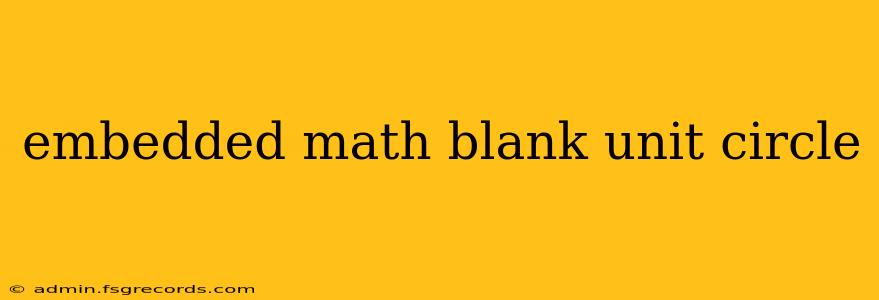The unit circle is a fundamental concept in trigonometry, forming the bedrock for understanding angles, radians, and the relationships between trigonometric functions (sine, cosine, and tangent). Many students struggle with visualizing and memorizing the unit circle, but with an embedded math approach—integrating visual aids and practical application—mastering it becomes significantly easier. This post explores effective techniques for truly understanding and utilizing the unit circle.
Visualizing the Unit Circle: Beyond Rote Memorization
Traditional methods often rely on rote memorization of coordinates. While memorization has its place, a deeper understanding emerges from actively visualizing the unit circle. Imagine a circle with a radius of 1 unit, centered at the origin (0,0) of a Cartesian coordinate system. This is your unit circle.
Key Angles and Their Coordinates:
The unit circle is defined by angles measured from the positive x-axis. Certain angles are particularly important:
- 0 radians (0°): (1, 0) The point lies on the positive x-axis.
- π/6 radians (30°): (√3/2, 1/2)
- π/4 radians (45°): (√2/2, √2/2)
- π/3 radians (60°): (1/2, √3/2)
- π/2 radians (90°): (0, 1) The point lies on the positive y-axis.
- π radians (180°): (-1, 0) The point lies on the negative x-axis.
- 3π/2 radians (270°): (0, -1) The point lies on the negative y-axis.
- 2π radians (360°): (1, 0) A full rotation back to the starting point.
These key angles, and their corresponding coordinates, are the building blocks of the entire unit circle. Instead of memorizing them individually, try to understand the patterns within them. Notice the symmetry and how the x and y coordinates relate to each other.
Understanding the Relationship Between Angles and Coordinates
The coordinates of any point on the unit circle (x, y) are directly related to the trigonometric functions:
- x = cos(θ) (where θ is the angle)
- y = sin(θ)
This fundamental relationship is crucial. It means that if you know the angle, you can find the sine and cosine values directly from the coordinates. Conversely, if you know the sine or cosine value, you can determine the angle.
Using the Unit Circle to Solve Trigonometric Problems
The unit circle is not just a visual aid; it’s a powerful tool for solving a wide range of trigonometric problems. For instance:
-
Finding trigonometric function values: Quickly determine sin(π/3), cos(π/4), or tan(π/6) by referencing the coordinates of the corresponding point on the circle. Remember, tan(θ) = sin(θ)/cos(θ).
-
Solving trigonometric equations: The unit circle allows you to visualize the solutions to equations like sin(θ) = 1/2 or cos(θ) = -1.
-
Understanding the periodic nature of trigonometric functions: The unit circle clearly demonstrates how sine and cosine values repeat every 2π radians (360°).
Embedded Math Strategies for Success
To truly embed this knowledge, consider these strategies:
-
Interactive Unit Circle Tools: Utilize online tools and apps that allow you to manipulate the unit circle interactively. See how changing the angle affects the coordinates and trigonometric function values.
-
Practice Problems: Work through a variety of problems that require you to use the unit circle to solve trigonometric equations and find function values.
-
Create Your Own Unit Circle: Draw your own unit circle multiple times, labeling the key angles and coordinates. This active process of creation reinforces learning.
-
Connect to Real-World Applications: Explore how the unit circle is applied in fields such as physics, engineering, and computer graphics. Understanding its practical relevance adds depth to your understanding.
By incorporating these embedded math techniques, you can transition from passive memorization to active understanding, mastering the unit circle and strengthening your foundation in trigonometry. Remember, the key is to visualize, understand the relationships, and practice applying the knowledge.

